Oh dear. We were supposed to chat about some whitework embroidery threads today. But – woe is me – my photos turned out just dreadful! So instead, I’ll share an update on the Secret Garden after some weekend stitching.
Deep down, I don’t like doing updates too frequently on the same project, because I fear you might be sitting on the other side of the computer screen, bleary-eyed and yawning from boredom.
After all, hand embroidery projects rarely develop at a Rapid Rate by today’s standards. Embroidery is a slow process – and I love it for that, most of the time.
But other times, I wish I were a Super-Fast-Bionic-Stitcher.
With sixteen arms.
And three heads.
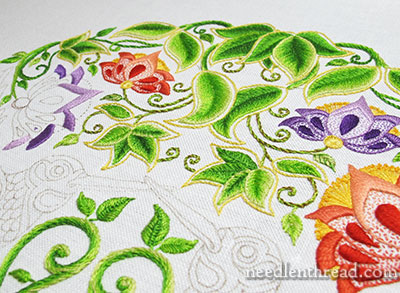
Alas, I am not.
And so today’s update features Flower 5, all embroidered, and Flower 6, partially embroidered.
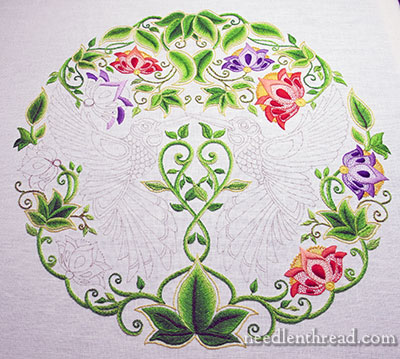
Flowers 5 and 6 are to the top left of center. Flower 5 is in the coral-red scheme, just to the left of center, and it is a relatively small little flower.
Notice that I didn’t embroider it in the purple scheme, like its opposite number to the right of center. I don’t want an exact mirror image here, so, working counterclockwise around the piece, I’m alternating colors on the flowers all the way around the ring.
I’ll end to the lower left of center with a larger purple flower.
This way, the piece is still balanced, but not exactly mirrored. And this way, if I vary my approach between the two birds, no one should be bothered about the piece not being an exact mirror image!
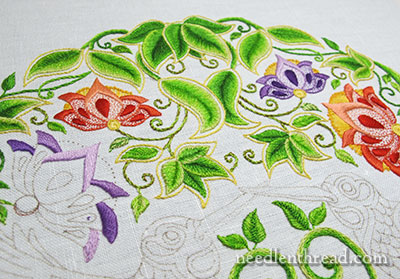
I’m working on the tips of the large purple flower on the left – the tips you can see in the lower left of the photo above. Because this flower is a little off balance (like the one on the right side, too, with an extra petal), I’m going to incorporate the very dark purple in the tips.
And this, I find troubling. Why troubling? You see, I find there’s a world of difference between embroidering with the darker purples on these satin stitched areas and embroidering with the corals / reds on the other flowers.
I don’t know why this is – it’s a phenomenon I’ll have to explore further – but I find it more difficult to achieve a very smooth satin stitch with really dark colors (like the darker purples). I wonder if it is the dye on the thread that makes it a little less soft, a little less spready, than the lighter colors.
Have you ever experienced a difference between thread behavior and feel, when working with really dark colored embroidery threads? Or is this all just my imagination?
I’ve noticed the same thing when stitching with plain black floss, too, by the way…
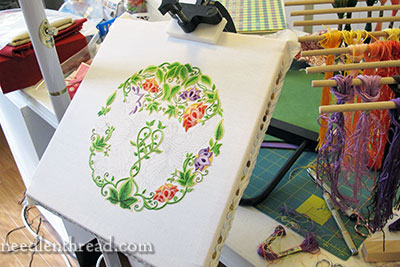
To put the piece, size-wise, into perspective (and to show you my typical State of Disarray at the End of the Day), here’s a shot of the embroidery on the frame which is held by my table stand, next to my repurposed embroidery thread rack holding all my discombobulated threads, on a messy table that’s piled with other fabric, books, and various needlework tools, all begging to be put away.
So you see, it isn’t all sunshine and roses and perfect order in my stitching world! No, no – it’s often a glorious Mess!
Now, tomorrow, something different! I will wrestle my camera to the ground today, and strive to bring about some decent pictures of some white threads.
We’ll have a good chat about them and we’ll talk rot.
No really – we will talk rot. Because I want to talk to you about thread rot.
See you then!
If you’d like to follow along with the Secret Garden Hummingbirds project, you can find all the articles relating to this project arranged in chronological order in the Secret Garden Project Index.


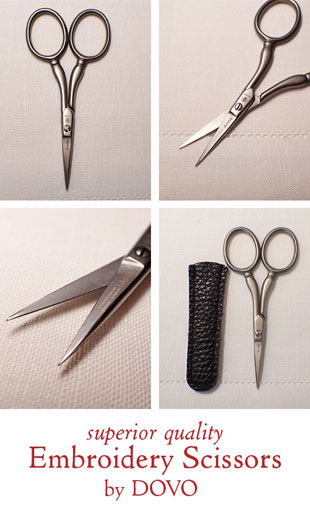
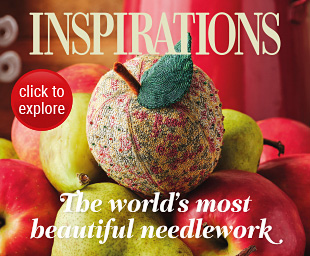


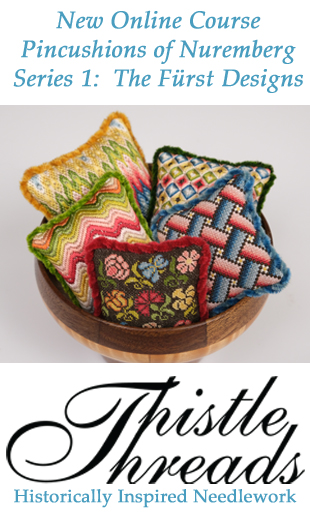
I like the alternating flower colours – they give a pleasing balance without too much symmetry. On circular designs, bilateral symmetry can make unwanted ‘faces’ appear in the shapes very easily.
Quite apart from any differences in dye thickness or stiffness, your eye doesn’t see edges very clearly if there’s no blue or black in a colour – except where there are shadows. So you won’t see the gaps between threads on warm reds and greens as sharply as on a darker or more blue shade. This can be very useful – your softening yellow edges on the green leaves took advantage the same visual trick, Mary.
Good comment about the visual effects of dark threads. My experience is that the dark (especially black) always feels different (more stiff, and more “wirey”?). I was lead to believe it was because of the dying process for dark, dark colors.
It’s not your imagination. There is a difference in texture between threads. A few month ago, I went on a shopping spree and bought myself one of each DMC color thread. While hand winding them on plastic bobbins, I noticed a big difference in texture and softness between the light and dark colored threads. The lighter ones almost felt like silk, they were so soft. And the darker the thread the rougher it felt, and not fun to wind on bobbins.
Btw, your secret garden is looking great. I don’t mind seeing so many pictures. It allows me to see your process 🙂
Hi Mary, thanks for the update. None of us get bored at all, since this is what we do. Your project is beyond colorful, it almost seems from India which is known for brilliant color usage in embroidery. Very pretty, very fancy! Please continue to keep us posted.
Mary I always enjoy your updates on the Secret Garden project, never bored! I can’t wait to start my flowers. Slow progress as I have been away for a month. Next week I hope to have photos to post on flicker. Best wishes Jude
Mary,
Your flowers are looking great. I love your color choices. You are right that different dyes change the texture and the feel of yarns and fabrics as well. I was recently sent some new to market fabrics and threads with no dye in them and I was shocked at how soft they felt as compared to those that are dyed. These fibers are all made from corn lactic acid for a special project. As you talk about rot, it is well known that the darker dyed fabrics and threads from the early 20th century rot faster than the lighter ones. I have black fabrics in an 80 year old quilt that are completely deteriorated, but the yellows and creams are still in great shape. Can’t wait to see what you have to say about this tomorrow.
Never bored, Mary. Beautiful work, lovely colors. I like the fact that you are not doing mirror image. But I do have one concern that I will mention, may not bother you, but “just in case”… Doing it every other flower will put it “heavy” on one side in corals, and on the other in purples. I’m not quite sure how to change it out and still have a good balance. Just something to think about? Perhaps you’ve already got this figured out with the birds or something. Just wanted to mention it.
Looking forward to the rot chat!
(This is Carol in MN who is “changing her name” because hopefully she’ll soon be “Carol in AR”) LOL.
Good morning, Mrs. Corbet. First let me start by saying that I could *never* get bored or bleary-eyed over The Secret Garden project! It’s too wondrously beautiful.
Second, I must say that I feel very guilty to admit this, but I am a mirror image freak! If everything isn’t exactly the same on *my* work my nerves get whipped into a tizzy! I have an OCD problem.
That humiliation aside, your work is *superlative* and I love it.
Finally, I personally haven’t noticed a difference in light vs. dark colors in satin stitch, but I do notice that black thread tends to give me more problems than all the rest put together!
ps. I have a rather “off topic” question… When using DMC floss, do you ever have a problem with it knotting in the skein? Whenever I’m winding it onto my bobbins, there’s always one or two skeins that I have to cut because of knots.
Hi, Kristina – ah, the pull skein problem. Yes, that often happens with pull skeins. If you’re going to take them apart anyway and re-wind them, take the tabs off and take the whole skein apart first, instead of pulling an end out. That helps. -MC
Thanks, Mrs. Corbet, I do take the tabs off, but I find it’s hit-or miss anyway. Like at this very moment I’m wrestling with a skein where the thread tangled and I had to snip to get everything under control. The next skein probably won’t. I just hate the waste of thread.
Your comments today about the ‘spreadiness’ of DMC embroidery floss really resonated with me. I am primarily a smocker (my cottage business), but love all kinds of embroidery. When doing picture smocking, it is an absolute truth that some colors ‘spread’ better than others. I always made the assumption that it was the dye used, but it is reassuring to know that it isn’t just me that thinks so!
I am never bored with any of your projects and I don’t even embroider – at least not yet! The detail and artistry you share is amazing. So worth reading each and every one of your articles – Thank you!
Dear Mary
Never bored with this beautiful project and I like the contrast of dark and light that you have managed so successfully in this project. I always find it more difficult to embroider with darker colours such as blues, purples and black then lighter thread colours and as other readers have pointed out perhaps it’s something to do with the dye. Your sewing room is just like mine when I am in the throws of and embroidery piece yes a mess which is as it should be! and I do love your thread rack. Ah tomorrow thread rot is going to be interesting can’t wait. Thanks for sharing your progress on the Secret Garden project.
Regards Anita Simmance
I don’t think I am going to sleep tonight… not now that you have mentioned thread rot!
Dear Mary – Never bored with updates!! I did start the Secret garden at the beginning but got bogged down by various annoying mistakes. So I put it away. Now I want to start from scratch and try again. Interim wasn’t wasted – I practiced long and short and other stitches. Now I feel more prepared to work the project.
Regards,
Doreen
Mrs. Corbet,
I’m glad that you don’t have sixteen arms and three heads. You look better as a human 😀 lol.
Good to know that it’s not just me having that problem with dark threads. It’s absolutely not just your imagination. I don’t know what it is. . . but lighter-coloured threads always behave differently that darker-coloured threads. I mean at least with DMC regular 6-stranded cotton floss. That’s the only embroidery thread I’ve ever used.
You really are moving along on the Project, Mrs. Corbet, and it looks wonderful. It’s so bright and spring-y and fun. I like it. You don’t have to worry about me getting bored and bleary-eyed with posts on this project. 🙂
Postscript:
I keep an “orts” jar, too. Mine is not nearly as large or full as yours, but I do have one. And my orts are not just from embroidery, but from sewing and other stuff like that, too.
Sarah
So far I haven’t been even close to bored with any of your progress reports. There always seems to be some interesting aspect for you to share.
Dark colors (not surprisingly) require more dye and associated chemicals than light colors. The fixatives are usually mineral salts, which will affect the “hand” of the fiber.
Silks, for example, are dyed using metallic salts to fix the dye which contributes to the fairly rapid degradation and “shattering” of darker colored silks over time. Back in the day unscrupulous silk merchants would use far more metal salts than required to increase the weight and density of the silk (which was sold by weight) Needless to say having even more sharp microscopically small bits of metal in the silk wasn’t good for it.
Oh Mary,Mary you could never bore,
When it comes to updates I want more.
I don’t read them once but more than twice
Whilst muttering ‘that looks nice’.
Now it seems I really aught
Be more careful with my orts.
No jar here, I have a tin
And when I mess about therein
Its not just rubbish that I find
But memories of the stitching kind.
My threads are old and some may rot
But throw them out, surely not
Its not their fault they fade and knot
It’s just because I’ve got a lot!!
In fact today I tipped some out
And spread the colours all about.
Picked up, put down with lots of thought
And then to the shop and new ones bought!
Don’t tell hubby, who came for the ride,
That when I got home I did decide
To use what I had, I was a bit too rash
So there is even more in my stash!
No rot from you, you wont’ hear us snoring
Cos Mary Corbet could never be boring.
Oh, this is just TOOOOOOO wonderful. Thank you. Love it, gotta try and keep it. What fun.
Carol
Well done!
Bored? Not me! It is just so refreshing to see the slow progress of work made by hand. It gives me time to enjoy the thought process that is going into the choice of thread, color and stitch. It allows to day dream about having time to plan, design and plan again then and slowly a small embroidery without constant interruptions, demands and rushing to one thing after another.
I like some symmetry, but not mirror images, it almost kills the creativity of a piece.
Dark thread are “stiffer” than light colored threads – I “felt” it in crochet with cotton and wool!
I don’t think I will get tired of reading about this project. I learn something new from each post because you take the time to explain your decisions. Such as why you chose to use purple thread for the flower. You are a great teacher!
Dear Mary,
I can’t wait till tomorrow! You see, after your discussion of discontinued whitework threads, I found some coton a broder at a market in our capital city when I was visiting family. I got 35 ecru and 4 skeins of 40 and 45 white coton a broder! Beautiful, but yellowing with age in some places. I’d love to know what I can do to bring the threads back to life before I stitch. I know it will be a challenge – not only to get it all white again (but not too white) but also to do it wihtout tangling the threads! Maybe I’ll have to reskein them.
I’m really keen to see your next post. Maybe I’ll get up in the middle of the night to check! Thank you so much for Needlenthread – my day is not the same without it. Here in Australia we have to start the week without you and that is very hard!
Mary, just one of the reasons I follow your blog, is your delightful sense of humour. The embroidery is great too!
I don’t have a problem with seeing lots of photos of your progress on one project – it’s all interesting to me. I may stop looking at this one when you get on to the middle section, but that is my problem.
I remember reading somewhere about black dye in particular having an effect on the structure of the thread. When I was very young I became an apprentice hairdresser for a while, and I found out that hair in its natural form is covered with scales that lie flat over each other but when you treat the hair chemically the little scales lift and make the hair rough. I guess it is similar with some dyes on fibres, and it would appear that black and other dark colours are the worst. It took me a while to work out that it was the colour of the thread that was affecting my satin stitch and not a) the weather, b) the way I was holding the needle, or c) the mood I was in, LOL.
I have noticed a definite difference in a color’s affect on thread/yarn. I was using a multicolor ball of cotton yarn to make a flower washcloth. It was so much harder to crochet the stitches with the purple and dark blue then with the yellow and orange. And, this was all in just in one skein! I had thought I had notices darker colors being stiffer before. I figured that those threads had to have more color/pigment in them to make them dark. I have not noticed a difference in DMC threads, however, between black and any other color.
Yes, the darker threads are slightly thinner. I got hooked with needlepoint and have used everything available. When doing a background or mounting border in floss (any brand, cotton or rayon), I usually need to add an additional strand of thread to get full coverage. I just have to try it out each time and see. Painting the canvas to match the thread doesn’t seem to help, except that the thin areas don’t blink light colors to make chambray. I hadn’t thought about it with satin stitch on fabric, but I played a little there and it is true.